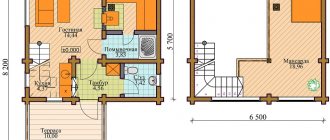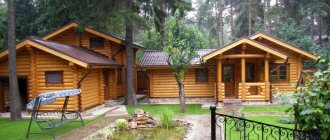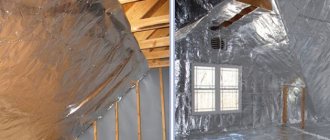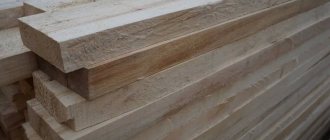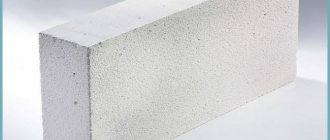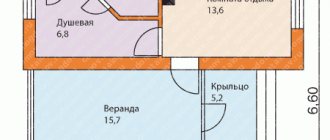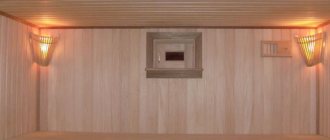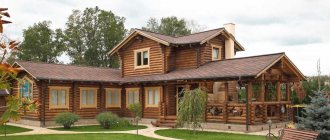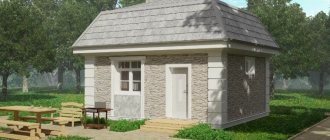Before implementing the wonderful idea of placing a sauna or steam room in the basement, you need to analyze how justified a bathhouse in the house is, the pros and cons of such a solution. The problem is much more complex than it might seem at first glance; in addition to purely construction problems, permitting issues will need to be resolved. First of all, this concerns fire safety and protection from possible negative factors associated with the proximity of the soil to the walls of the bathhouse.
Bathhouse in the basement
Undoubtedly, the layout of a bathhouse or sauna inside a residential building provides enormous advantages. In a classic building layout, a sauna or steam room is installed on the ground floor of the building or attached to a box in the form of a utility block. The option is quite reliable, but ineffective, since you have to give up valuable living space in the house for a bathhouse, or occupy the local area. Much more interesting is the scheme for moving the bathhouse to the basement of a private house. In this case, it becomes possible to save at least 20-25 m2 and at the same time insulate the basement of the building.
The prospect is tempting, but not everything is so simple. To arrange a bathhouse or sauna in the basement of a private house, you will need to solve quite complex problems:
- Waterproofing and insulation of the basement under the house, thermal insulation of load-bearing structures and ceilings;
- Combating high air humidity in the bathhouse, equipping with effective supply and exhaust ventilation;
- Equipment of the sauna or bathhouse premises with a special sewage system;
- A set of fire safety measures.
When building a bathhouse in the basement of a house, modern materials will be used for waterproofing and insulation, which either burn well or are capable of releasing toxic volatile substances during thermal decomposition.
Features of the arrangement
Building a bathhouse is a very complex and difficult process. No matter who says it, but here you need to have certain knowledge, as well as skills, in order to erect the building correctly and quickly. If we are talking about the basement or basement of a garage, then the cost and price of the project is significantly reduced. It will also be much faster and easier to build all this, which makes such projects very attractive for people who want to save money or have insufficient experience in construction.
If you want to build such a building in an apartment building, then this is also legal, but before construction you need to obtain permission from other residents, as well as fill out certain documents.
A project for building a steam room in a residential building should look something like this:
- steam room parameters;
- functional plan for the placement of premises;
- diagram of the main communications;
- calculation of materials that will need to be spent.
When arranging a steam room in the basement of a garage or residential building, you need to pay attention to the following factors:
- If you didn’t have time to add a bathhouse to the project, you definitely need to do this.
- If the basement was previously used for economic purposes, this change must be made to the documentation.
- To safely operate the building, it is necessary to correctly install the chimney so that it has minimal contact with the walls.
High humidity
The first factor, not particularly dangerous, but extremely important, is the high level of air humidity. Any baths, both free-standing and inside the house, are built from materials that conduct water vapor well. Logs, bricks, foam concrete - in all cases, part of the moisture leaves the room through pores in the walls. Even if left idle for a long time, the sauna room sooner or later dries out to its natural humidity level.
If you build a bathhouse or sauna in the basement of a private house, the reverse process will be observed; a certain part of the groundwater will seep through cracks and pores in the basement walls. Accordingly, the premises of the steam room, dressing room, dressing room, if special measures are not taken, will be damp and cold.
Therefore, when planning a bathhouse in the basement of a house, you will need to do:
- Drainage of the foundation and perimeter of the basement walls;
- Apply insulation to the outer wall;
- Lay waterproofing of the floor, walls and ceiling of the future bathhouse.
For your information!
Depending on the method of finishing and heating arrangement of the sauna, internal insulation and cladding can be laid according to a ventilated or non-ventilated scheme. In the latter case, a space or gap 4-5 cm thick is left between the concrete basement wall and the insulation of the bathhouse or sauna, through which condensation and the remains of leaked groundwater will be removed from the sauna. Since the bathhouse in the basement will be located in an isolated space, without artificial supply and exhaust ventilation, the insulation and wooden cladding will quickly fail.
Leak protection and sound insulation
The sauna is, first of all, a source of strong humidity and noise. The stage of arranging water and noise protection systems is very expensive, but experts do not advise saving on it, since the effect of insufficient work will be low.
Thermal insulation and waterproofing are done for all surfaces of the steam room. The ceiling must be covered with double layers of protection.
It would be optimal to use rolled materials, since they are the most durable and create few joints during installation. It is better to choose foil-based materials, carefully adjust all joints to each other, gluing them with foil tape. To ensure that the insulation does not come into contact with the cladding of the room, it is necessary to make slats for installation.
A sauna in the basement will not interfere with the residents of the house to lead their normal daily routine - all sounds will be absorbed by the finishing of the room’s surfaces.
Fire safety
The most difficult issue that one has to face when arranging a bathhouse in the basement of a private house with their own hands concerns the problem of fire safety. It is known that among outbuildings, fires most often occur in saunas and steam rooms. The reason is always the incorrect installation of the heater in the bathhouse or violation of the rules of its operation.
In conditions when the bathhouse is moved to the basement, the situation becomes even more complicated, primarily due to the requirements of SNiP and fire safety rules:
- Firstly, the rules of SP 4.13130.2009 prohibit the installation of heating devices operating on the basis of fuel combustion in basements. As an alternative, an electric boiler or steam-water heating registers connected to a boiler on the ground floor of the house can be used to heat a bathhouse or sauna in the basement;
- Secondly, for heating the steam room and the entire room, only certified industrial stoves and heaters with automatic safety and blocking devices can be used when the heating temperature reaches an excessive temperature;
- Thirdly, the design of the bathhouse must include a fire alarm, a fire extinguishing system and a fire-resistant door that allows blocking the flame front inside the basement.
In addition, the bathhouse must have an emergency exit, providing the opportunity to leave the premises in the event of a fire. It is clear that in order to obtain permission from the Ministry of Emergency Situations to install a bathhouse in the basement, it will be necessary to use non-flammable materials or special fire-retardant impregnations for wood for finishing.
Electric heating or wood?
It is not easy to answer the question: what type of stove to choose for a home bath in the basement. First of all, because it is very difficult to define specific criteria that would allow such an unambiguous assessment. Even if we take into account energy efficiency, cost or ease of use, this comparison can only be made on individual models representing a given type of heating.
What to consider when choosing stove types
| Varieties | Peculiarities |
| Single-component electric furnaces. | Dry sauna stoves, in which we pour water (usually with the addition of essential oils) onto heated stones to obtain higher humidity. |
| Electric dual-function ovens. | This is a stove with an evaporator (for example, from the Bi-O series), which will fill the bath with dry, humid air or steam. |
What to choose? The answer usually lies in the preferences of the person planning their own home bath in the basement. In technical questions regarding the possibility of using specific stove models in rooms intended for bathhouse needs, it is worth consulting with production and assembly specialists.
Bathhouse in the basement: advantages
For a sauna or steam room built on the base of a building, the safety conditions are not so stringent. Standards remain for the installation of fire-resistant doors; walls and partitions inside the bathhouse on the ground floor must be made of brick, concrete, or in the form of metal frame structures with fire-resistant backfill.
You can use stoves with a closed combustion chamber to heat the bath. In this case, the loading hatch of the firebox is moved outside the walls, into an extension to the house. A stainless steel chimney is laid along the outer wall, or discharged through the ceiling of the house, as in the diagram.
The height of the pipe must be at least 5 m above the level of the combustion chamber.
Often, home owners strive to build a basement version of a bathhouse or sauna. This solution provides high-quality protection of the foundation from frost heaving of the soil. In addition, a sauna box buried in the ground in winter is much more economical in energy consumption compared to free-standing baths.
According to SNiP rules, it is forbidden to store flammable objects and things in the basement; it is forbidden to arrange living quarters and rooms in which a person can stay for more than eight hours at a time. Therefore, installing a steam room will be the best solution to the problem of rational use of space. Good thermal insulation of the floor and walls of the sauna in the basement reduces heat loss through the ceiling of the first floor, and in addition, regular heating of the basement bathhouse dries the outer surface of the walls well and protects them from dampness and overgrowing with moss without any finishing.
For your information! A sauna in the basement of a private house is safer than a basement, since improved ventilation and the presence of windows seriously reduce the risk of radioactive radon accumulation.
Private gay sauna "Thermas"
Moscow's private gay sauna "Termas" is a closed club, which can be accessed with a club card. But it’s definitely worth getting there. The main highlight of Termas is the interior, designed in a chamber but chic style. There are no random visitors here, which creates an atmosphere of privacy and relaxation.
In addition to the sauna itself, there is a restaurant hall with amazingly delicious cuisine. You can spend time in the karaoke room, and the bar will delight you with truly unusual and high-quality alcohol and cocktails.
In addition to the common areas, Termas has several separate VIP rooms, each of which is distinguished by its own design and has its own distinctive features.
Room No. 1 is decorated in European style, there is a huge bed, and there is the ability to watch videos. Room No. 2 is stylized in Russian traditional style. It is she who is most often chosen for intimate conversations and closer acquaintance and privacy. Room No. 3 is an original space covered in mirrors. Being in it will give you unforgettable emotions.
On Tuesdays and Thursdays, Termas hosts an excellent show program. Famous drag queen shows perform here, as well as casting for new massage therapists.
Address: Moscow, Tsvetnoy Boulevard street, building 30.
Gay sauna opening hours: from 14:00 to 06:00.
Entrance only with club cards.
Entry fee:
500 rubles – young people under 25 years old,
1300 rubles – men over 25 years old.
Sauna in the basement of the house: project
Traditionally, the basement area under the building is built over the entire area of the foundation. One of the layout options is shown in the project below.
In addition to a bathhouse or sauna, a boiler room or furnace room must be built on the ground floor; there may be a garage, a tool warehouse and a small recreation room. Small windows in the upper part of the relaxation room soften the cutting effect of artificial lighting well, so with proper equipment of a bathhouse in the basement or basement, the level of comfort is no worse than in ground-based steam rooms and saunas.
If you don’t want to bother with permits and fire safety permits, you can use the project shown in the diagram below to plan the room for a bathhouse and build partitions.
At first glance, there are not so many advantages from such an organization of the room; only a small part is used effectively, and even then, you have to steam in a sauna measuring 2x2 m.
There are no partitions in the basement, but there is a swimming pool, shower, washing machine and a place to relax. It is the absence of internal walls that provides the most important thing for a bathhouse located in a semi-basement - good ventilation, fresh air and enough space to participate in health procedures.
Technical details
It is worth noting right away that building a bathhouse in the basement is an expensive procedure, since installation work will have to be carried out in an already erected structure. If you need to organize a sauna in a building that is under construction, then the process will be extremely simple.
First of all, for proper implementation, you need to resolve all communication issues.
During the arrangement process, the following points should be taken into account:
There is no need to have a pool here
If it is built, then close attention must be paid to ventilation. For washing, the optimal solution would be shower cabins, the size of which is selected taking into account the area of the room. The cabins should not be installed inside the steam room, but opposite it. The presence of a pipeline is a prerequisite, since without it there will be no constant supply of water. The ideal solution for this would be your own well, which can be drilled directly on the site
If there is a central water supply, then its use will be more comfortable.
A bathhouse that is designed for long-term use must be equipped with drying equipment. The ideal solution would be fans or air conditioners, but it is better to entrust the installation to a professional who can take into account all the nuances.
Construction of a sauna in the basement
When arranging a bathhouse in a basement or semi-basement, first of all you need to take care of wall insulation and waterproofing. The primary layer of expanded polystyrene and roofing felt are laid around the perimeter of the outer surface of the walls.
This is followed by the application of a coating waterproofing mastic inside the future bathhouse. After the insulation layer has dried, they proceed to installing load-bearing sheathing on the basement walls, which will hold the thermal insulation and lining of the bathhouse.
It can be made from a galvanized profile or wooden slats; wood can be used for sheathing in the basement without restrictions, provided it is impregnated with silicone fire-resistant varnishes or fire retardants.
In any case, there must be an air gap between the wall and the layer of mineral insulation. The ceilings and floors of the bathhouse are made in a similar way. The laid insulation is laid with a vapor barrier and sewn up with finishing material. OSB-3 boards, which have high strength and are resistant to water and open flame, are traditionally used as a rough covering in the basement.
Project #2 - a simple sauna in one weekend
The process itself:
Step 1. We measure the existing basement and determine the future size of the bathhouse. Step 2. Finish the walls and floor Here - special attention: there really should be a floor, and, preferably, in the form of tiles or porcelain stoneware. Step 3. We bring ready-made materials for the frame to the basement. We assemble them on the floor or directly on the wall - as is convenient for you. According to SNiPs, the walls of a built-in steam room or sauna must be built at a distance of at least 50 mm from the walls of the room. In principle, such an air gap is additional ventilation and heat protection, because the outer wall of the basement will always be cold in relation to the wall of the steam room. Step 4. Now the wall frame needs to be protected from the so-called “wet” floor. To do this, you can lift and fix the frame itself on the wall, or directly place it on an aluminum profile, as in our photo instructions. Step 5. Let's move on to the sheathing. In this case, we assembled the frame in a square, and therefore it is easy to finish. We start the sheathing from the outside. Step 6. We attach bars to the outer walls every 50 mm, and attach a vertical beam to it. Then we cover it with a roofing membrane. The advantages of this technology: the insulation will not fall out into the ventilation gap, any moisture that accidentally gets into it will be removed quickly, and water will not get in from the outside either (in the event of a flood from above). Step 7. After this we install the main frame of the sauna. Calculate the pitch based on the width of the insulation minus one centimeter. As such, take “stone wool”, i.e. basalt, and the harder it is, the better. Foil Izover is also good, just point it outward with the foil. Step 8. We make wiring for future lamps and leave ventilation holes. Use heat-resistant wire. Step 9. We insulate the frame: the walls are 50 mm, and the ceiling is 100
It is important that there is at least a small ventilated space under the ceiling. Step 10. Using a stapler, attach the foil
For this purpose, use either special reinforced foil on a thread - it is easier to work with, or regular, but dense one. Cover all joints and even staples from the stapler with foil tape. Step 11. Now we create a ventilation gap between the foil and the lining. To do this, we stuff slats 18-20 mm thick on top of the foil, and only on it do we attach the lining. Step 12. Place the shelves. In this design, mortgages are better. Step 13. Selecting a stove. For such a sauna, calculate the power as follows: 1 kW per 1 cubic meter. We take the control panel outside the steam room. Step 14. Attach the lamps and cover them with lampshades.
That's all! All that remains is to treat the lining and wooden elements with special oil.
As for ventilation in this project, here the ventilation hole under the stove takes air from the dressing room, and returns it from the steam room there. And all this is in one room, and therefore there is no reverse draft.
Ventilation and sewerage
The second most important element of a sauna is the ventilation and ventilation system. For a bathhouse located below ground level, an exhaust air exchange system is used. This means that overheated and over-humidified air is removed through a ventilation pipe in the corner of the ceiling.
In a small sauna, it is enough to install one exhaust shaft to ventilate the gap between the walls and the insulation and two pipes for the interior of the bath. One of the vertical air ducts is located in the steam room, in the area of the shelves. Thanks to the exhaust pipe, part of the superheated air from the stove enters the sauna steam room in the shortest possible way and heats the shelves to 60-70 ° C.
In full-size saunas, ventilation ducts and ducts are hidden behind the ceiling sheathing and connected to a centrifugal fan located in a moisture-free area of the basement.
To remove dirty and waste water in the bathhouse, special collection containers are used, from which the collected material is discharged outside the basement.
Stage 7. Finishing the premises
Wood paneling
Decorative cladding
For the interior decoration of a sauna, including a steam room, it is preferable to use stone or natural low-resin wood. Oak, linden or aspen wood is especially popular. It is strictly not recommended to use coniferous wood due to the ability to release resins and sticky gluten when high temperatures are reached.
Sauna interior
Among other things, natural wood species, having high heat capacity and moisture resistance, as well as good sorption properties, will help maintain a favorable microclimate in the steam block. Shelves and benches are made from the same types of wood as the wall decoration.
Door selection
Sauna doors
When choosing a door, preference should be given to those panels whose material is most resistant to humidity and high temperatures. The door must close tightly and be free of metal elements (except for hinges). This is a very important point, especially regarding the door handle on the inside of the steam room.
At the moment, wooden, glass and combined doors are popular.
Drain shaft
When designing a sauna, you should allocate space for a vertical drain shaft at an optimal depth for non-freezing in winter. To purify water, a mesh is placed in the shaft.
Pouring the floor
The most popular and well-proven foundation for use in saunas is a strip foundation, in which the top layer of the floor is filled with a liquid concrete solution. Floors are often laid on top of concrete with ceramic or tiles. And in order to be able to stand without burning your feet, a wooden sheathing is made on top of the tiles or removable wooden panels are placed on top.
Sauna floor
Light
Light in the sauna
The number and size of lighting fixtures used in sauna design depends entirely on the imagination of the owners. The installation of electrical wiring should be done responsibly, because incorrect work can cause a fire.
Choosing a stove
Stove in the sauna
The stove is a fundamental element of the steam room. A correctly selected and installed unit will ensure the operation of the entire sauna. Modern manufacturers offer a wide range of models of both wall-mounted and floor-standing stoves - the location is not important, because the walls of sauna stoves practically do not heat up due to the design features.
In any case, it is recommended to surround the stove with an enclosing structure. For basement saunas, it is preferable to give preference to electric stoves due to their maximum safety, compactness and efficiency. Other parameters (power, control system, etc.) of the model are selected based on the total area of the sauna and steam room block. The stones are placed evenly in such a stove, but not too tightly, so as not to interfere with the heated air circulating freely throughout the steam room.
Kiln stones
Since the stones in the steam room are the only source of steam, their choice should be approached carefully.
There are a number of requirements for stove stones:
- sufficient heat capacity;
- heat resistance;
- heat resistance to large temperature changes;
- ecological natural purity.
Sewage disposal system
Removing dirty water at the end of bath procedures is not as simple as it might seem at first glance. The reason is obvious - the basement itself is located below the level of the sewer pipes and drains of the house.
Therefore, all wastewater in the basement is collected in a sealed tank or cistern connected to the sewer riser of the house at the level of the first floor. An air compressor is connected to the container with waste water; after turning it on, excess air pressure forces the collected liquids into the general sewer system of the house.
Sometimes bathhouse owners take a more expensive and reliable route; instead of a compressor, a submersible fecal pump is installed in a collection tank in the basement subfloor, capable of pumping the contents directly into a septic tank or cesspool.
Style and design
First you need to determine the number of people that your home sauna should accommodate at the same time. You should also consider whether the allocated room is even capable of coping with the task of comfortably accommodating so many people. There are different options for constructing saunas, and choosing the right type often helps to make the most of even a small square footage of a home bathroom.
The pool, unlike the sauna, is laid out with ceramic tiles, but you can choose the same patterns or colors on the ceramics and lining wood to combine them into a single design. It is advisable to make a small corner to place a table and chairs or sofas, because after the bath procedures the body will need a little rest.
Also, saunas can be divided into several types depending on the temperature and humidity inside:
Bath drainage system
Upon completion of the bath procedures, the problem arises of how to remove the remaining humid air and traces of condensation from the basement. If this is not done, then most of the water vapor will settle on the insulation and condense on the floor and ceiling of the sauna.
There are two schemes for the bathhouse drainage system. In the first case, for small saunas, the heat of cobblestones laid on the grid of an electric heater is used. The heat reserve of the stone heated to 150°C is enough to dry the steam room of the bathhouse, most of the walls and the washing tray. To speed up the process, an inlet window for fresh air is installed in the basement, next to the heater.
For large sauna rooms, a heater is clearly not enough, so to dry the basement, they use forced supply and exhaust ventilation. Most of the air enters through cracks in the basement flooring and is exhausted through the exhaust pipe.
If the size of the sauna in the basement does not exceed 10 m2, a conventional fan heater mounted in the lower part of the coldest wall of the sauna can be used as a dehumidifier.
Dehumidifiers
A bathhouse in the basement will also require the installation of a dehumidifier. It will be especially useful if, in addition to the steam room in the basement, it is planned to build a mini-pool, a plunge pool, or install a jacuzzi.
Externally, the dehumidifier is similar to a monoblock type air conditioner. It is equipped with a fan and radiator that allow you to:
- air conditioning,
- remove vapors from the air that, during operation of the unit, settle on the radiator in the form of condensate (there is a special tray for draining condensate),
- supply dried and slightly heated air into the room.
If desired, you can install a small window air conditioner in the room - it will also be able to do the job of dehumidifying the air, but its operating efficiency will be low, and the noise generated will be quite strong.
Craftsmen recommend not using foam plastic as a finishing material for the walls or ceiling of the steam room. When it is heated to high temperatures, it may release substances that are toxic to humans. Natural hardwood has always been considered the best finishing material for a steam room; so far it has not been possible to find a worthy replacement for it.
It is not recommended to cover the wooden walls, ceilings and floors in the steam room with paints or varnishes - under the influence of temperature they can release harmful substances. If protective antifungal agents are used, then only those approved for use in the steam room.
Heating
The heating system for a bathhouse in the basement can be divided into two independent circuits. The first is used for general heating of the sauna, providing hot water for the steam room and shower. For these purposes, a double-circuit gas boiler installed in the utility room of the first or basement floor, outside the bathhouse, is ideal.
If the house does not have water heating, then to heat the basement you can use an industrial solid fuel boiler with automation and a built-in heat exchanger. In any case, the source of hot water should be installed outside the basement and bathhouse.
The second scheme is used to heat the sauna. In this case, only a factory-made electric heater should be used for the basement. The wiring for connecting the electric heater is laid behind the wall cladding, always in asbestos or fiberglass sleeves. Metal or plastic corrugations cannot be used. The heater must be equipped with grounding and UDO, the control panel is mounted on the wall at the entrance to the steam room of the bathhouse.
According to the conditions of SNiP, an electric stove for a bath in the basement must be equipped with an automatic shutdown when the maximum temperature reaches 150 ° C and a timer that de-energizes the heater after 8 hours of continuous operation.
Beautiful examples
- An excellent bathhouse made of natural wood, which is made in a minimalist style.
- A luxurious bathhouse in a large basement, which includes a relaxation area.
- Bathhouse with a separate shower room and shower stall. The lighting inside creates a unique microclimate and allows you to relax.
- Sources used in the article:
https://stroy-banya.com/karkas/banya-pod-domom-v-podvale.html - https://stroyday.ru/stroitelstvo-doma/pridomovye-postrojki/sauna-svoimi-rukami-v-podvale.html
- https://stroypomochnik.ru/banya-v-podvale-01/
- https://o-vannoy.ru/banya/vse-o-saunah-v-podvale/
- https://PlanVsem.ru/banya/banya-v-cokolnom-etazhe.htm
- https://poparimsya.online/stroitelstvo/banya-dom/podvale-sauna.html
- https://bouw.ru/article/banya-v-podvale-chastnogo-doma
Materials for arranging a home sauna
As with most above-ground bathhouses, linden and aspen lining is used to line the steam room in the basement. Usually masters do not want to use fire retardant impregnations in the sauna, considering them harmful, but in vain. This coating increases the ignition temperature of the wooden cladding of the bathhouse walls from 180°C to 310-350°C. Otherwise, the fire inspector will be forced to install a dry pipe fire extinguishing system in the sauna.
To finish the rest of the walls of the bathhouse in the basement, OSB, waterproof plywood and plasterboard are used. The shower section in the sauna, if there is no cabin, is tiled. Apart from impregnated wood and mineral materials, nothing can be used to finish the walls in the basement.
To insulate a bath, two types of materials can be used. In the first case, the ceiling, walls and floor of the sauna can be insulated with special heat-resistant PBS-S foam, provided that the sheets of material are covered in the basement with cement screed or ceramic tiles.
In the second case, the insulation of the walls and ceiling is carried out with mineral wool with a two-layer patch of waterproof plasterboard and tongue-and-groove strips. Such a sandwich is not afraid of moist hot steam and at the same time protects the basement thermal insulation layer well from condensation.
Steam room assembly
After determining the location of the sauna and making an individual project, they begin to assemble the steam room. According to sizes:
- vertical and horizontal bars are installed;
- all corners of the structure are checked;
- outside the frame, the walls are sheathed with sandwich panels, clapboard or plywood;
- Insulation is laid on the inside, and a vapor barrier layer is placed on it;
- all joints are carefully covered with foil tape;
- internal walls are sheathed with longitudinal or transverse slats made of non-coniferous wood;
- similar actions are performed with the ceiling;
- the floor inside is covered with ceramic tiles, on top of which a grating is installed so as not to burn your feet;
- build two shelves for a comfortable position while sitting or lying down;
- a stove (floor or wall) is installed with an enclosing structure.
When assembling the steam room, do not forget to follow the instructions
Walls and ceiling
The internal parts must be made of panels of suitable wood, at least 12 mm thick. To build a bathhouse in the basement, the following are most often used:
- Scandinavian spruce;
- Canadian spruce;
- cedar, which is an ideal material for a sauna.
It is important that the wood has as few marks of knots as possible and a minimum amount of resin (to ensure maximum comfort). Under the layer of wood panels in the basement there should be thermal insulation, preferably made of mineral wool
The thickness of the layer can range from 45 to 100 mm. Expanded polystyrene is not resistant to high temperatures, so insulation should not be made from polystyrene boards. Proper thermal insulation is a very important element of the sauna cabin. This reduces heating time to minimal operating costs.
Baths in the basement can also be made from solid wooden logs - then the use of mineral wool will not be necessary. The room does not require additional protection from moisture. Contrary to popular belief, this is the driest room in the entire house. In principle, the walls can be finished with any material: wood, fiberboard or plaster. To protect the wooden wall elements from absorbing water collected on the sauna floor, they must be installed on aluminum profiles.
Assembly work
We assemble the bathhouse in the basement in the following order:
- We assemble the metal frame of the partitions and walls of the room;
- We lay ventilation and sewerage communications, water supply to the shower cabin;
- We lay power electrical cables to the heaters in the steam room, the fan and the boiler of the shower cabin, lay the wiring to the lighting points in the steam room, shower and rest room;
- We lay thermal insulation, vapor barrier, line the walls and partitions of the bathhouse with wooden lining made of linden or larch;
- We install taps, lighting fixtures, and hang doors.
At the first stage, it is necessary to attach vertical racks made of thin-sheet metal profiles to the basement walls with a pitch of 60 cm. The verticals on the walls are connected by short crossbars, after which fiber mats, a vapor barrier film are laid, a sheathing made of wooden slats is laid, and a sheet of foil foam is laid. A ventilation gap of 15-20 mm thick is installed between the foamed heat insulator and the outer wooden cladding. Internal partitions are assembled in a similar way, with the exception of the use of mineral insulation.
Any structures made of metal profiles inside the steam room of a bathhouse are installed with thermal gaps in the connections, otherwise the first attempt to warm up the steam room in the basement will lead to deformation of the frame or even destruction of the walls.
